Lunenburg, Nova Scotia is one of the most photogenic small towns I’ve visited in North America.
Located on the province’s picturesque South Shore, Lunenburg captured my attention from the moment I drove into town on my Nova Scotia road trip. Colorful old buildings line the streets that stretch up the hill from the harbor where fishing boats bob along the wharf and head out to sea.
Lunenburg is one of only two urban communities in North America that is designated as a UNESCO World Heritage site, recognized as being the best surviving planned British colonial town on the continent. Old Town Lunenburg was recently recognized by Canada Post in a special commemorative stamp issue celebrating Canadian UNESCO sites. The Lunenburg stamp depicts a scene from a vantage point near those in the photos above and below.
In keeping with British colonial policy, Lunenburg was built as the second “model town” (after Halifax) in June 1753 and settled by German-speaking Protestant German, Swiss and Montbéliardian French colonists. The policy dictated that the towns would have seven north-south streets, 48 feet wide (with the exception of King Street, which is 80 feet) and intersected at right angles by nine 40 feet wide east-west streets with blocks divided into 14 lots of 40 by 60 feet each. Although there are 21 North American settlements which were designed with this plan, Lunenburg is the only one that has remained in such excellent condition, maintaining much of its original appearance.
There’s more to tell about the history, mystery, and attractions of Lunenburg. But for now, I’ll give you a glimpse of the color and character of this lovely town.
UNESCO Fresco
King Street in Old Town Lunenburg, nicknamed “UNESCO Fresco”, has a number of dining, shopping, and lodging establishments in charming landmark buildings within short walking distance of the harbor and other attractions. The view shown below is from Memorial Park where a monument honors citizens of Lunenburg and the surrounding area who died in World War I. The colorful buildings on King Street include Cilantro – The Cooks Shop, a family owned-and-operated kitchenware retail store, and the adjacent Rime Restaurant.
Also on King Street is the main building of the Mariner King Inn where the reception, breakfast room and several guest rooms are located. And…. there’s also a ghost who some claim to have seen around the inn and from outside in the top window looking out to sea.
At the corner of King and Pelham Streets is the Mariner King Inn’s aptly-named Cranberry Suites addition where I spent two nights in a top floor suite overlooking King Street. As far as I know, there isn’t a resident ghost in this building, but I was alert for one.
Along Montague Street
Heading toward the harbor and turning left onto Montague Street from King Street, I spotted a horse-drawn carriage in the distance. It seemed to better suit the ambiance and architecture of the shops, inns, restaurants than the vehicles parked along the street.
More colorful and historic Lunenburg buildings
Two-thirds of Lunenburg’s buildings date from the 19th century and at least eight are from the founding period during the 18th century. Many of them have historic property designations. These are just a few of those that caught my eye.
At 49 Cornwallis Street is the Finck Holder House (above) which was built in 1829. At the turn of the 20th century, Mr. Finck boarded up all of the windows on the north side of the house in an effort to protect his daughters from the eyes of peeping Toms living in the tenement house next door.
Built in 1888, the Allan R. Morash (above) house is a large, two-story house with a central “Lunenburg bump”, a dormer characteristic of many homes in Lunenburg.
The Lennox Inn (above) was built in 1791 and is the oldest continuously operating inn in Canada.
Boscawen Inn (above) is a lovely Queen Ann style structure on the hillside overlooking Lunenburg Harbour and the Old Town. It was built in 1888 by prominent Lunenburg figure, Senator H.A.N. Kaulbach, as a wedding present for his daughter. It also has its share of ghost stories.
Built at the turn of the 20th century, Walters Blacksmith Shop is now the Ironworks Distillery (above)– as charming on the inside as it is on the outside. I spent a lovely time here sampling a variety of handcrafted spirits, including the Ironworks Apple Brandy that I used in my Nova Scotia Surprise recipe.
St. John’s Anglican Church at 65 Cumberland Street was the second Anglican church in Nova Scotia, built in 1753. It is designated as a Provincial Heritage Property and National Historic Site. On November 1, 2001, there was a fire in the church that resulted in considerable damage and the need for a four-year restoration project. I toured inside the church and will share photos later.
Located on Gallows Hill and surrounded by one of Lunenburg’s oldest cemeteries is Lunenburg Academy, built between 1893-1895. As you can see above, it can appear a little eerie on a rainy night — especially while on a ghost tour with Lunenburg Walking Tours. It is a large three-story building, an example of late Victorian eclectic architecture. It is historically significant in the development of Nova Scotia’s educational system as it evolved in the 19th century from one-room schoolhouses to the Academy system. It’s the only surviving building from the Nova Scotia Academy system that is still a functioning school.
A few bonus glimpses
What are your favorite picturesque towns?
Thanks to Nova Scotia Tourism Agency and Taste of Nova Scotia for giving me a glimpse of lovely Lunenburg.

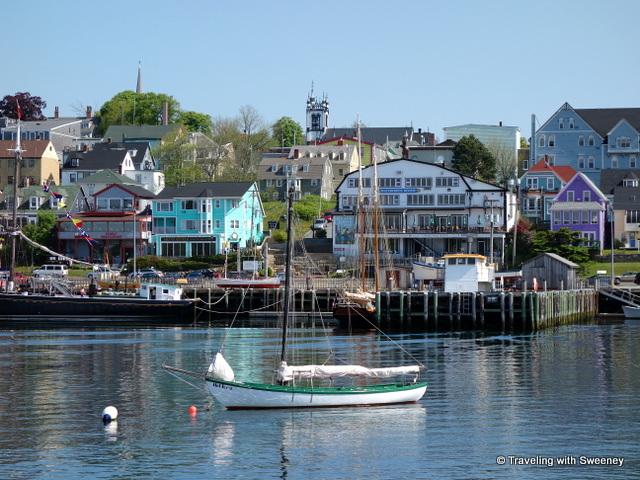
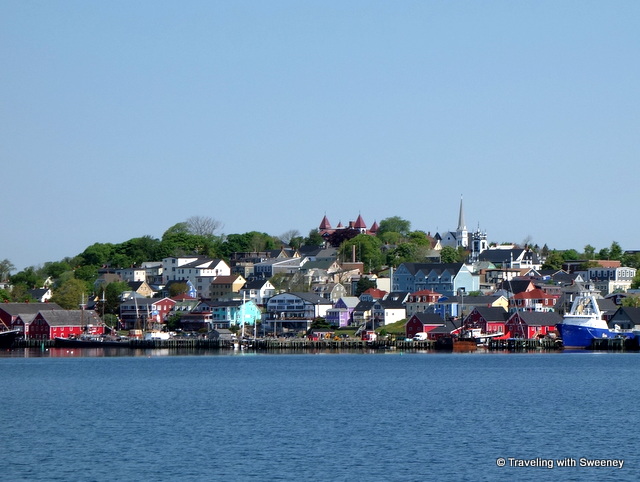
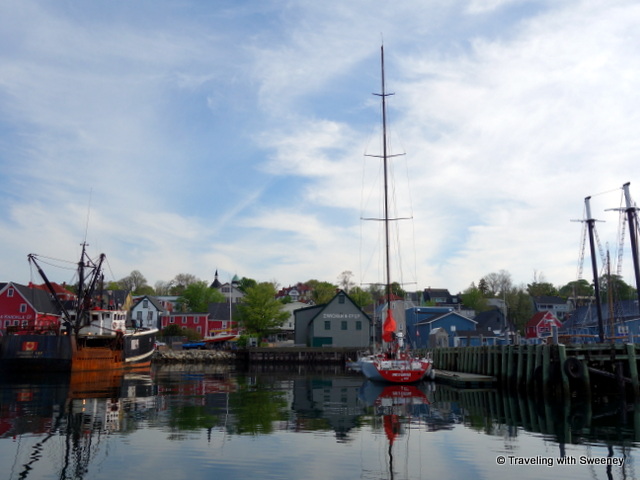

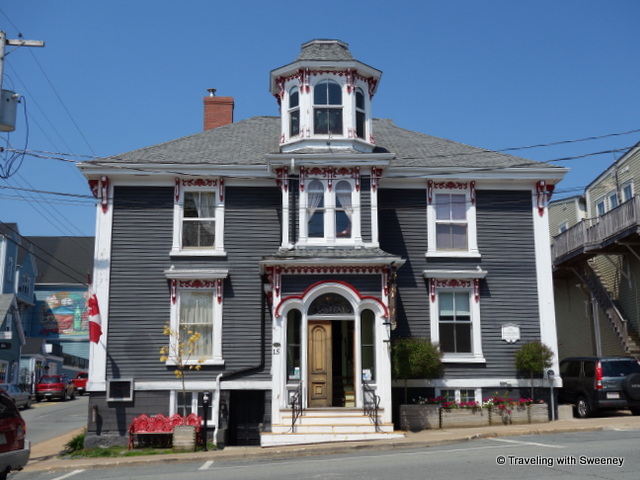
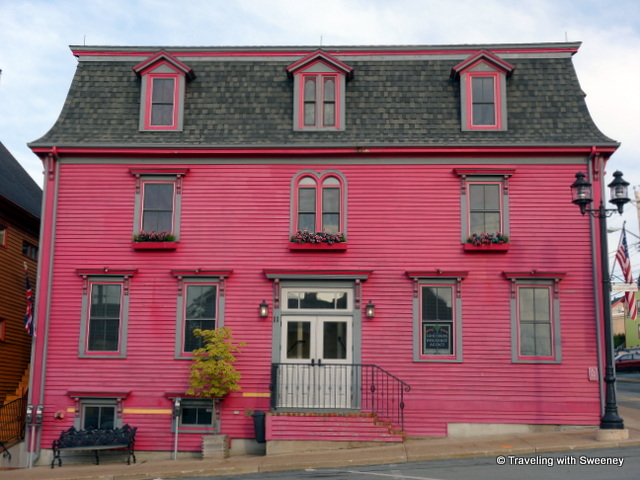
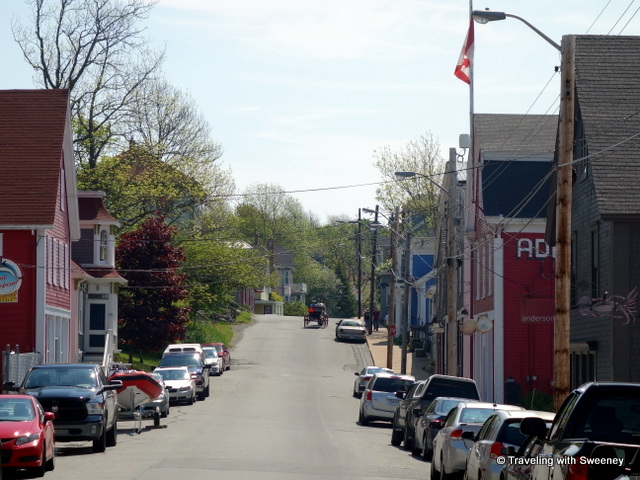

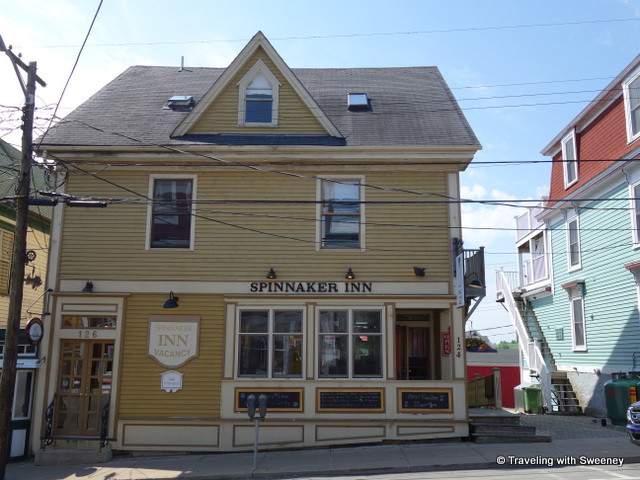

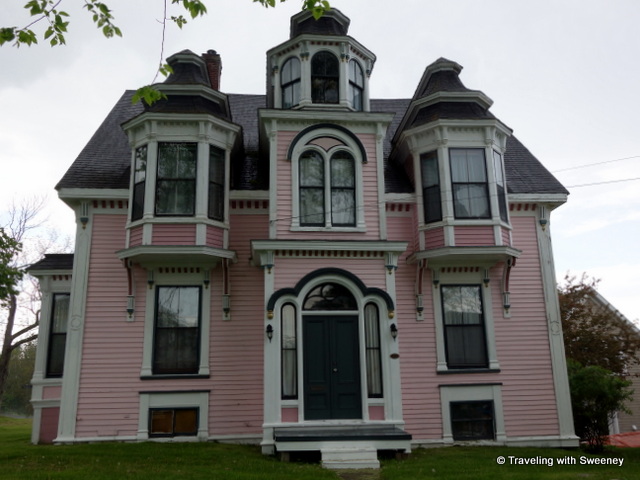
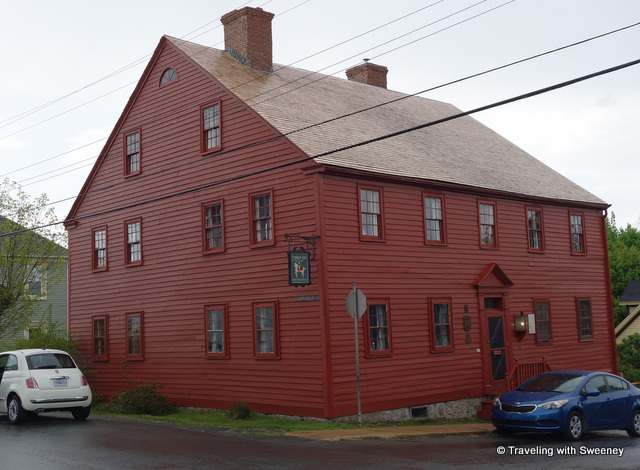
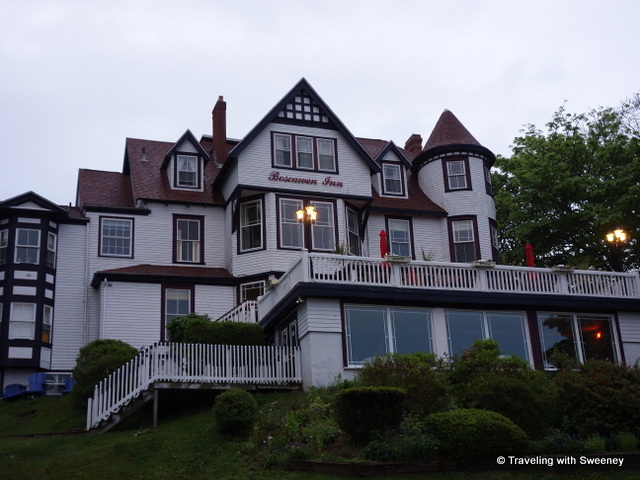
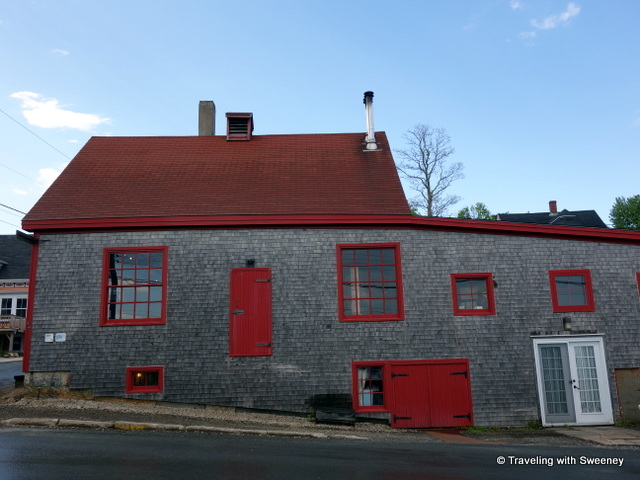
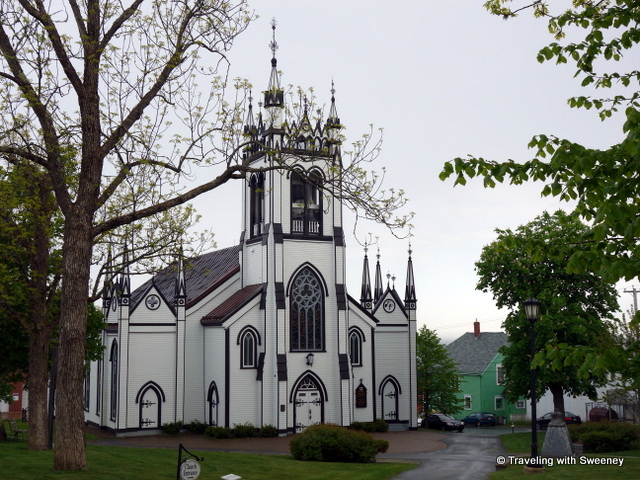
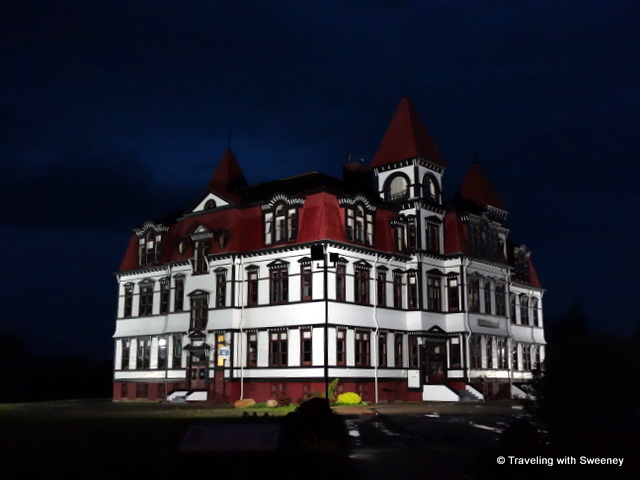

Some interesting buildings and history you’ve given us today!
Lunenburg looks like a gem. Such beautiful buildings! You asked my favorite picturesque town. One is definitely Cape May, New Jersey, which I visited for the second time last year. Here’s a rundown, http://travelswithcarole.blogspot.com/search/label/Cape%20May
Haven’t been to Cape May. Thanks for the link – I’ll check it out!
I love Lunenburg! The museum gives a real sense of the essence of the people, and their determination. The buckets of fresh mussels aren’t tough to take either! Thanks for the trip back east!
The museum is really well done. In addition to the artifacts and information, it’s wonderful to see how much pride the people have for their heritage.
I have never seen a bad photo of Nova Scotia – what an incredible place it is. At first I fell in love with the grey and white Mariner photo and then I saw the Cranberry Suites – what a beautiful building and colour. The whole town is captivating though.
Good point, Jan! Can’t say that I’ve seen a bad pic of Nova Scotia either. 🙂 Lunenburg is especially photogenic.
Beautiful city 🙂
Such a picturesque harbour! And the buildings look so colourful. Thanks for sharing!
This sounds fantastic, Cathy! I would love to take that horse drawn carriage ride 🙂 What is up with the story of Mr. Finck boarding up all of the windows and peeping toms?? That made me laugh out loud! For a spontaneous answer to your question and locales you and Mr TWS are no doubt very familiar with. There are some very picturesque gold rush towns on Hwy 49 in the California foothills going east from Yuba Pass 🙂
Oh, you are so right about those old gold rush towns in California. Columbia comes to mind at the moment.
Cathy, Beautiful shots of intriguing spaces. I’m envisioning these spaces dressed up in autumnal finery or wrapped in winter’s snowy blanket – truly a setting for all seasons.
I hear you, Maria. I’d love to see Lunenburg in fall and winter. Talk about lovely and charming!
Lunenburg is a charming village. I am amazed at how detailed the town planning instructions are and am glad that its layout has been preserved for so long. I’ve always been a fan of Victorian architecture, and I see many buildings I like in this post. That Academy practically glows against the dark sky.
I hadn’t previously heard about the British colonial “model town” plans. Interesting, isn’t it?
What great photos. They really capture the town, architecture and ambiance!
You have made Lunenburg come alive for me with your beautiful pictures! What a trip!
Thanks, Nancy — I guess my mission was accomplished! 🙂
Wow, certainly is picturesque! You got some great shots of the buildings, all of which are very well preserved! Thanks for sharing!
The colors of the buildings! Wow. Interesting information about the planning of the town. Thanks for this!
Aren’t those colors gorgeous? And they’re so well kept up, which I imagine isn’t easy with salt air and winter weather.
Lunenberg is very picturesque, Cathy. I never would have guessed that it was a planned British town with all the vibrant color there. I’m surprised the Brits didn’t give it a proper English name.
As I read through I kept thinking of Old Town Alexandria, Virginia and Annapolis, Maryland. Must plan a trip there soon.
I haven’t been to Annapolis, but I loved Old Town Alexandria.
Lunenberg is such a beautiful and quaint town and I’d love to see it someday. Your photos are beautiful and the history is very interesting!
Hi Cathy, thanks for the tour of Lunnenberg. I looks very charming. I love its burst of colors.It’s great that old homes and inns are well preserved. The anglican church is so stunning; what an exquisite architecture. You did really capture the eeriness of the academy. I heard so much beautiful things about Nova Scotia. I hope to visit soon.
We visited Lunenburg for a couple of hours on a day trip from Halifax about 8 years ago – I have wanted to go back ever since!!
Lunenburg really is easy to reach from Halifax — great day trip, but I’d find it hard to leave.
Definitely a picturesque town! I love the bold colours and that church is so beautiful!
What a pretty place – the wooden buildings and bright colours really remind me of some of the fjord villages in Norway I visited earlier this year!
Reminds me of pics I’ve seen of Norway — hope I get a chance to make a comparison first hand sometime.
I am in love with this post, Cathy! I think I commented on one of your earlier posts that I think I’d love Lunenberg. It’s got all the charm and scenery that I imagine an historic harbor town to have. I really love the look of St. John Anglican Church. Very striking.
What a pretty little town! The types of buildings remind me of some of the mansions in the little towns near and in my hometown in Pennsylvania. I’d love to visit Nova Scotia because it looks like there is a lot to see and do there.
Just lovely! That first photo alone makes me want to visit… And “UNESCO fresco” is such a cool and catchy name – it seems this town has lots of character! I could see myself walking around the streets and then sitting by the water with a book. Not a bad idea, huh?
What a lovely place, just beautiful. The academy looks very impressive and I love that pink house 🙂
Isn’t Lunenburg just lovely… we adored the brightly coloured houses, the cheerful little harbour, and the great cafes. A ghostly walking tour sounds wonderful.
Pingback: Mariner King Inn: Impressions and a Tasty Surprise » Traveling with Sweeney
We’re proud as Canadians to have this UNESCO-protected site in our country :-). It’s a lovely site… We visited on a cruise from Boston and remember eating delicious lobster rolls there.
The UNESCO Town of Lunenburg is a gem. A stunning photo essay of the architectural highlights of the town.